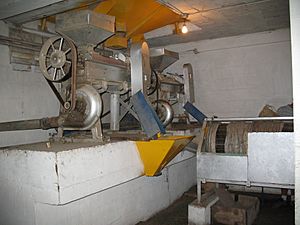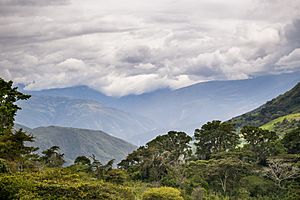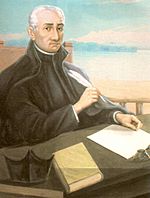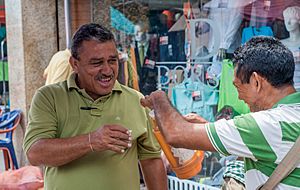Coffee production in Venezuela facts for kids
Coffee production in Venezuela started a long time ago, in the late 1700s and early 1800s. This happened in the lower parts of the Andes mountains. A priest named José Gumilla brought coffee to Venezuela in 1732. People started growing a lot of coffee because many wanted to buy it. Also, land was cheap, and workers were available. Venezuela first sent its coffee to Brazil. Growing coffee in Venezuela caused many people to move to the region in the late 1800s. Even though Venezuela was once a big coffee producer, like Colombia, by 2001 it made less than one percent of the world's coffee.
Contents
Where Coffee Grows in Venezuela
Coffee grows well in Venezuela's Coast Range and western Andean mountains. It just needs good soil and enough moisture. In the Andes, coffee farms often look like a forest. They have 3 to 4 layers of different plants. Taller trees provide shade for the coffee plants to grow. This area is part of Venezuela's three main regions. These are the Mountains and Caribbean Coastal region, the Llanos region, and the Orinoco River Delta and Guayana regions.
Coffee farms are usually found at heights of 1,000–5,000 feet (300–1,520 m) above sea level. This area is near the border with Colombia. Better coffee grows even higher, at 6,000 feet (1,800 m) or more. But coffee plants grow slower there and produce less. The fertile highland areas are in Táchira, Mérida, and Trujillo. These places are known as the Andean frontier region. They are great for growing coffee that can be sent out from the Maracaibo port. This helped coffee production grow a lot in the 1800s.
The Duaca region is special for coffee growing. Until 1916, wealthy farm owners there wanted private land. They hoped this would make workers earn more money. In the 1860s, coffee growing boomed in Duaca. This was because migrating farmers could stand up to the big landowners. However, things changed between 1908 and 1935. New political rules meant most land became private. This helped the large farms and made farmers lose their power.
Coffee also started growing in drier, lower areas, under 600 metres (2,000 ft). These areas produced less coffee, about 300 kg per hectare each year. But small farmers made up for this by growing other crops too. Studies show that most coffee farms are on Andean hills. They are usually between 800–1,700 metres (2,600–5,600 ft) high, on slopes from 5 to 60%. Most landowners were small farmers. They owned 87.5% of the land. Each farm had about 3.5 hectares (8.6 acres) of coffee. They used traditional farming methods with many layers of plants.
Coffee is a plant that grows year after year. About 280,000 hectares (690,000 acres) of land is used for coffee. The Andes region alone has 125,000 hectares (310,000 acres) of coffee farms.
History of Coffee in Venezuela
A priest named José Gumilla brought coffee to Venezuela in 1732. In the 1770s, cocoa was the main crop in Venezuela. It was grown on large farms using slave labor. But from 1793, many big coffee farms started to appear.
By the 1800s, coffee became the most important farm crop. From 1811 to 1823, cocoa production went down. But coffee production grew a lot. In the 1830s, Venezuela was the third largest coffee exporter in the world. The war for independence also hurt cocoa farming. But coffee growing kept rising. This was because coffee prices were high in countries near the Atlantic Ocean. Venezuela also had free trade deals with these nations. Later, Antonio Guzmán Blanco became a powerful leader (from 1871). During his time, Venezuela grew a lot. The city of Caracas developed greatly. Coffee production also increased fast. This was helped by loans from other countries.
Venezuelan leaders tried to get European farmers to grow coffee. But they didn't succeed. Instead, farmers from the Andes and Colombia naturally moved to areas good for coffee.
Juan Vicente Gómez ruled Venezuela for 27 years (from 1908 to 1935). He used the money from coffee and oil to develop the country. In 1919, coffee and cocoa made up 75 percent of Venezuela's exports. The main buyer was the U.S.
In 2003, the Venezuelan government set rules for coffee prices. This limited how much coffee was grown. Because of this, Venezuela had to import coffee. They brought in about 50% of what they needed. Most imports came from Brazil and Nicaragua. Coffee growers say it's not profitable to grow coffee under these rules. But the government says farmers are hiding coffee to sell it for more money. A report from coffee growers said it cost US$335 to produce a certain amount of coffee. But they could only sell it for US$173, due to government limits. All these changes made Venezuela lose its place as a top coffee exporter. The future of these rules is unclear after the death of President of Venezuela, Hugo Chávez, who started them in 2003. Coffee production in Venezuela is now much lower. It is only about 1% of what the world produces.
Types of Venezuelan Coffee
The coffee sent out from the Maracaibo port is called "Maracaibos." It has different kinds like Cucuta, Mérida, Trujillo, and Tachira. Coffee from the eastern mountains is called Caracas, named after the capital city. These are local names for Venezuelan coffee.
Globally, coffee falls into two main types. One is Arabica (Coffea arabica L.). This type grows better in high mountain areas. The other is Robusta (Coffea canephora p. ex Fr.). This type grows in lower areas. Arabica coffee often grows under a forest roof, while Robusta grows with some shade.
Quality of Venezuelan Coffee
"Lavado Fino" is the best grade of coffee in Venezuela. The highest quality Venezuelan coffee reportedly comes from the western region, near Colombia. This coffee is shipped from Maracaibo and is also called "Maracaibos." This coffee has "bright flavors with a clean, crisp finish." It is also light and simple. It is less acidic than other coffee from Latin America.
Coffees from the coastal mountains further east are usually called Caracas. They are named after the capital city and shipped through La Guaira, the port of Caracas. Caripe coffee comes from a mountain range near the Caribbean Sea. It often has the soft, gentle taste of island coffees from the Caribbean. No matter the market name, the best grade of Venezuelan coffee is Lavado Fino. This means "fine, washed."
Coffee Production Process
Coffee trees can be harvested about four years after they are planted. Each tree can live for about 50 years. Farmers usually pick coffee twice a year. The first picking is in October and November. The second, larger harvest is in December, January, and part of February. However, the picking season changes depending on how high up the farm is. Trees at heights greater than 3,000 feet (910 m) are picked later than those at lower elevations.
Before 1914, coffee production reached 1 million bags per year. After local use, Venezuela's coffee exports were second only to Brazil. In the Andean frontier region, coffee production grew ten times between 1830 and 1930. This made Venezuela the second largest coffee producing nation. In 1919, over 82,000 tonnes of coffee were produced. However, poor farming methods, soil erosion, less rain, and overusing the soil caused a big drop in coffee yield in the 1920s. This led to the decline of the coffee industry. Oil extraction also contributed to its downfall.
Usually, most coffee is produced in December and January. Venezuelan coffee is shipped between October and May. Most coffee grown in Venezuela is drunk by people living there. The rest is mainly sold to the United States, Belgium, and Germany.
Today, Venezuela produces less than one percent of the world's coffee. Most of it is consumed by Venezuelans themselves. However, some interesting Venezuelan coffees are starting to appear again in the North American specialty market. The best-known Maracaibo coffees, besides Cúcuta, are Mérida, Trujillo, and Táchira. Mérida coffee usually has a fair to good body and a pleasant, sweet flavor with hints of richness. Táchira and Cúcuta coffees are similar to Colombian coffees. They have a rich acidity, medium body, and sometimes a fruity taste.








